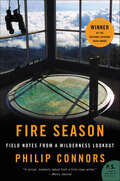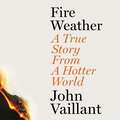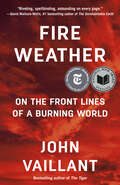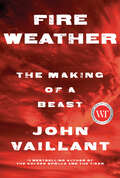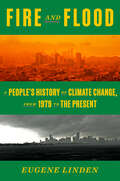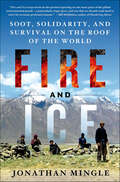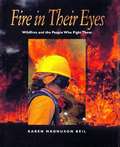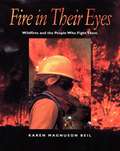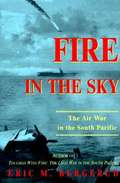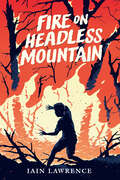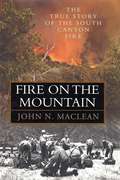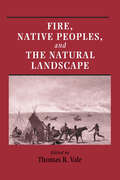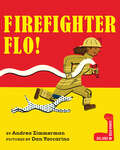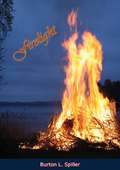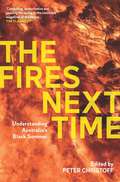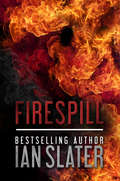- Table View
- List View
Fire Management in the American West: Forest Politics and the Rise of Megafires (G - Reference, Information And Interdisciplinary Subjects Ser.)
by Mark HudsonMost journalists and academics attribute the rise of wildfires in the western United States to the USDA Forest Service's successful fire-elimination policies of the twentieth century. However, in Fire Management in the American West, Mark Hudson argues that although a century of suppression did indeed increase the hazard of wildfire, the responsibility does not lie with the USFS alone. The roots are found in the Forest Service's relationships with other, more powerful elements of society--the timber industry in particular. Drawing on correspondence both between and within the Forest Service and the major timber industry associations, newspaper articles, articles from industry outlets, and policy documents from the late 1800s through the present, Hudson shows how the US forest industry, under the constraint of profitability, pushed the USFS away from private industry regulation and toward fire exclusion, eventually changing national forest policy into little more than fire policy. More recently, the USFS has attempted to move beyond the policy of complete fire suppression. Interviews with public land managers in the Pacific Northwest shed light on the sources of the agency's struggles as it attempts to change the way we understand and relate to fire in the West. Fire Management in the American West will be of great interest to environmentalists, sociologists, fire managers, scientists, and academics and students in environmental history and forestry.
Fire Season: Field Notes from a Wilderness Lookout
by Philip Connors“Fire Season both evokes and honors the great hermit celebrants of nature, from Dillard to Kerouac to Thoreau—and I loved it.”—J.R. Moehringer, author of The Tender Bar“[Connors’s] adventures in radical solitude make for profoundly absorbing, restorative reading.”—Walter Kirn, author of Up in the AirPhillip Connors is a major new voice in American nonfiction, and his remarkable debut, Fire Season, is destined to become a modern classic. An absorbing chronicle of the days and nights of one of the last fire lookouts in the American West, Fire Season is a marvel of a book, as rugged and soulful as Matthew Crawford’s bestselling Shop Class as Soulcraft, and it immediately places Connors in the august company of Edward Abbey, Annie Dillard, Aldo Leopold, Barry Lopez, and others in the respected fraternity of hard-boiled nature writers.
Fire Weather: A True Story from a Hotter World
by John VaillantA stunning account of this century's most intense urban fire, and a panoramic exploration of the rapidly changing relationship between fire and humankind. In May 2016, Fort McMurray, Alberta, the hub of Canada's oil industry, was overrun by wildfire. The multi-billion-dollar disaster turned entire neighbourhoods into firebombs and drove 90,000 people from their homes in a single afternoon. Through the story of this apocalyptic conflagration, John Vaillant explores the past and the future of our ever-hotter, more flammable world.For hundreds of millennia, fire has been a partner in our evolution, shaping culture and civilization. Yet in our age of intensifying climate change, we are seeing its destructive power unleashed in ways never before witnessed by human beings. With masterly prose and cinematic style, Vaillant delves into the intertwined histories of the oil industry and climate science, the unprecedented devastation wrought by modern wildfires, and the lives forever changed by these disasters. Fire Weather is an urgent book for our new century of fire.'John Vaillant is one of the great poetic chroniclers of the natural world' David Wallace-Wells'A towering achievement; an immense work of research, reflection and imagination' Robert Macfarlane(P) 2023 Penguin Audio
Fire Weather: A True Story from a Hotter World
by John Vaillant'Astounding on every page. John Vaillant is one of the great poetic chroniclers of the natural world' David Wallace-Wells'A towering achievement; an immense work of research, reflection and imagination' Robert MacfarlaneA gripping account of this century's most intense urban fire, and a panoramic exploration of the rapidly changing relationship between humanity and fire's fierce energy.In May 2016, Fort McMurray, Alberta, the hub of Canada's oil industry, was overrun by wildfire. The multi-billion-dollar disaster turned entire neighbourhoods into firebombs and drove 90,000 people from their homes in a single afternoon. Through the story of this apocalyptic conflagration, John Vaillant explores the past and the future of our ever-hotter, more flammable world.For hundreds of millennia, fire has been a partner in our evolution, shaping culture and civilization. Yet in our age of intensifying climate change, we are seeing its destructive power unleashed in ways never before witnessed by human beings. With masterly prose and cinematic style, Vaillant delves into the intertwined histories of the oil industry and climate science, the unprecedented devastation wrought by modern wildfires, and the lives forever changed by these disasters. Fire Weather is urgent reading for our new century of fire.
Fire Weather: On the Front Lines of a Burning World
by John VaillantPULITZER PRIZE FINALIST • A NEW YORK TIMES TOP TEN BOOK OF THE YEAR • FINALIST FOR THE NATIONAL BOOK AWARD IN NONFICTION • A stunning account of a colossal wildfire and a panoramic exploration of the rapidly changing relationship between fire and humankind from the award-winning, best-selling author of The Tiger and The Golden Spruce • Winner of the Baillie Gifford Prize for Non-FictionA BEST BOOK OF THE YEAR: The New York Times, The Washington Post, The New Yorker, TIME, NPR, Slate, and Smithsonian&“Grips like a philosophical thriller, warns like a beacon, and shocks to the core." —Robert Macfarlane, bestselling author of Underland&“Riveting, spellbinding, astounding on every page.&” —David Wallace-Wells, #1 bestselling author of The Uninhabitable EarthIn May 2016, Fort McMurray, the hub of Canada&’s oil industry and America&’s biggest foreign supplier, was overrun by wildfire. The multi-billion-dollar disaster melted vehicles, turned entire neighborhoods into firebombs, and drove 88,000 people from their homes in a single afternoon. Through the lens of this apocalyptic conflagration—the wildfire equivalent of Hurricane Katrina—John Vaillant warns that this was not a unique event, but a shocking preview of what we must prepare for in a hotter, more flammable world.Fire has been a partner in our evolution for hundreds of millennia, shaping culture, civilization, and, very likely, our brains. Fire has enabled us to cook our food, defend and heat our homes, and power the machines that drive our titanic economy. Yet this volatile energy source has always threatened to elude our control, and in our new age of intensifying climate change, we are seeing its destructive power unleashed in previously unimaginable ways.With masterly prose and a cinematic eye, Vaillant takes us on a riveting journey through the intertwined histories of North America&’s oil industry and the birth of climate science, to the unprecedented devastation wrought by modern forest fires, and into lives forever changed by these disasters. John Vaillant&’s urgent work is a book for—and from—our new century of fire, which has only just begun.
Fire Weather: The Making of a Beast
by John Vaillant#1 NATIONAL BESTSELLERWINNER OF THE BAILLIE GIFFORD PRIZE FOR NONFICTION • FINALIST FOR THE HILARY WESTON WRITERS' TRUST PRIZE FOR NONFICTION • FINALIST FOR THE NATIONAL BOOK AWARD IN NONFICTION • ONE OF THE NEW YORK TIMES&’ TOP TEN BOOKS OF THE YEAR • A stunning account of the colossal wildfire at Fort McMurray, and a panoramic exploration of the rapidly changing relationship between fire and humankind from the award-winning, best-selling author of The Tiger and The Golden Spruce.Named a Best Book of the Year by The Guardian • TIME • The Globe and Mail • The New Yorker • Financial Times • CBC • Smithsonian • Air Mail Weekly • Slate • NPR • Toronto Star • The Washington Post • The Times • Orion MagazineIn May 2016, Fort McMurray, the hub of Canada's petroleum industry and America's biggest foreign supplier, was overrun by wildfire. The multi-billion-dollar disaster melted vehicles, turned entire neighborhoods into firebombs, and drove 88,000 people from their homes in a single afternoon. Through the lens of this apocalyptic conflagration—the wildfire equivalent of Hurricane Katrina—John Vaillant warns that this was not a unique event but a shocking preview of what we must prepare for in a hotter, more flammable world. For hundreds of millennia, fire has been a partner in our evolution, shaping culture, civilization, and, very likely, our brains. Fire has enabled us to cook our food, defend and heat our homes, and power the machines that drive our titanic economy. Yet this volatile energy source has always threatened to elude our control, and in our new age of intensifying climate change, we are seeing its destructive power unleashed in previously unimaginable ways. With masterly prose and a cinematic eye, Vaillant takes us on a riveting journey through the intertwined histories of North America's oil industry and the birth of climate science, to the unprecedented devastation wrought by modern forest fires, and into lives forever changed by these disasters. John Vaillant's urgent work is a book for—and from—our new century of fire, which has only just begun.
Fire and Flood: A People's History of Climate Change, from 1979 to the Present
by Eugene LindenFrom a writer and expert who has been at the center of the fight for more than thirty years, a brilliant, big-picture reckoning with our shocking failure to address climate change. Fire and Flood focuses on the malign power of key business interests, arguing that those same interests could flip the story very quickly—if they can get ahead of a looming economic catastrophe.Eugene Linden wrote his first story on climate change, for Time magazine, in 1988; it was just the beginning of his investigative work, exploring all ramifications of this impending disaster. Fire and Flood represents his definitive case for the prosecution as to how and why we have arrived at our current dire pass, closing with his argument that the same forces that have confused the public&’s mind and slowed the policy response are poised to pivot with astonishing speed, as long-term risks have become present-day realities and the cliff&’s edge is now within view. Starting with the 1980s, Linden tells the story, decade by decade, by looking at four clocks that move at different speeds: the reality of climate change itself; the scientific consensus about it, which always lags reality; public opinion and political will, which lag further still; and, perhaps most important, business and finance. Reality marches on at its own pace, but the public will and even the science are downstream from the money, and Fire and Flood shows how devilishly effective moneyed climate-change deniers have been at slowing and even reversing the progress of our collective awakening. When a threat means certain but future disaster, but addressing it means losing present-tense profit, capitalism&’s response has been sadly predictable. Now, however, the seasons of fire and flood have crossed the threshold into plain view. Linden focuses on the insurance industry as one loud canary in the coal mine: fire and flood zones in Florida and California, among other regions, are now seeing what many call &“climate redlining.&” The whole system is teetering on the brink, and the odds of another housing collapse, for starters, are much higher than most people understand. There is a path back from the cliff, but we must pick up the pace. Fire and Flood shows us why, and how.
Fire and Ice: Soot, Solidarity, and Survival on the Roof of the World
by Jonathan MingleHigh in the Himalayan valley of Zanskar in northwest India sits a village as isolated as the legendary Shangri-La. Long fed by runoff from glaciers and lofty snowfields, Kumik—a settlement of thirty nine mud brick homes—has survived and thrived in one of the world's most challenging settings for a thousand years. But now its people confront an existential threat: chronic, crippling drought, which leaves the village canal dry and threatens to end their ancient culture of farming and animal husbandry. Fire and Ice weaves together the story of Kumik's inspiring response to this calamity with the story of black carbon. Black carbon from inefficient fires - the particulate residue that makes soot dark - is the second largest contributor to global warming after carbon dioxide. It's also a key ingredient of the air pollution that public health experts regard as humanity's greatest environmental health risk worldwide: soot-laden smoke from household hearth fires and outdoor sources combine to kill over seven million people around the world every year. Jonathan Mingle describes the joys and struggles of daily life in the Zanskar Valley, where villagers are buffeted by powerful environmental and economic forces, while also tracing black carbon's dark fingerprints outward from Kumik and around the world. Mingle investigates its impacts on snow, ice, and water from Mt. Everest to California, and the silent health epidemic it fuels from New York to New Delhi. Combining cultural history, detailed reportage, climate and energy science and dramatic storytelling, Fire and Ice is a profound examination of the global challenges of averting climate chaos and lifting billions out of energy poverty and water scarcity. Can Kumik's people come together to reinvent fire, harness what remains of their life-sustaining ice, and reinvigorate their traditions of solidarity, in time to save themselves? Can the rest of us rise to the same challenge? Fire and Ice connects these questions with the work of enterprising scientists, engineers, entrepreneurs and activists around the world, in a narrative that combines mythology, reason, humor, persistence, and hope in a race against a global clock.
Fire in Their Eyes: Wildfires and the People Who Fight Them
by Karen Magnuson BeilDepicts the training, equipment, and real-life experiences of people who risk their lives to battle wildfires, as well as people who use fire for ecological reasons.
Fire in Their Eyes: Wildfires and the People Who Fight Them
by Karen Magnuson BeilWhat drives some people to stand in the path of a wall of flame? Who are these brave, foolhardy, visionary firefighters? This intimate look at the elite groups that fight wildfires explores the trials, tragedies, and triumphs of these courageous few as they battle wilderness blazes from Alaska to Maine. From the grueling training of a smokejumper class in Montana, through harrowing fights with some up-close-and-personal wildfires, to a group of inspired conservationists who use fire as a tool for preservation, Karen Magnuson Beil takes readers where only a few have ventured--into the heart of one of nature's most destructive and unpredictable forces: fire.
Fire in the Heart: A Memoir of Friendship, Loss, and Wildfire
by Mary EmerickFIRE IN THE HEART is a powerful memoir by a woman, once a shy, insecure schoolgirl, who reinvented herself as a professional wildland fire fighter. Determined to forge herself into a stronger, braver person, Mary climbs to heights she never imagined for herself, eventually directing blazes across the country. Filled with literal struggles for survival, tough choices and Mary's burning passion for what she does, Fire in the Heart, is an unflinching account of one woman's relationship with fire. But when she loses someone she loves to the famous Storm King Mountain forest fire in Colorado, which killed fourteen firefighters, Mary faces the hardest choice of her life; to stay in the game or turn back and try to find the woman she used to be. It is both a thrilling memoir about life-threatening work and a meditation on identity, strength, bravery, bonds, and survivor's guilt.
Fire in the Sky: The Air War in the South Pacific
by Eric M. BergerudThis book explores the technology, tactics, 3-D battlefield, leadership, living conditions, medical challenges and morale of the combatants during WWII in the air over the Pacific.
Fire on Headless Mountain
by Iain LawrenceSeparated from his siblings in the midst of a dangerous forest fire, 11-year-old Virgil must find a way to survive using only his wits and the lessons his late mother taught him about the wilderness.Virgil is making his older siblings trek to a mountain lake on a trip unlike any they&’ve have taken before. They carry precious cargo: the ashes of their beloved mother, who asked that her remains be scattered at her favorite spot. But when a forest fire is sparked by a bolt of lightning at the exact moment when their van breaks down, the journey quickly turns to disaster. While the oldest, Josh, is gone to find help, Virgil and his sister, Kaitlyn, spot fleeing animals and soon see flames flickering above the tree line. Once the sky begins to darken with the haze of burning timber, Virgil finds himself separated from his sister and left alone in the wilderness. He isn&’t sure he can make it, but with the memory of his late mother, a science teacher, and all her lessons to guide him, he quickly learns that not everything has a perfect explanation and survival starts with letting go. Fire on Headless Mountain showcases not only the overwhelming beauty and terrifying power of nature, but also the gift of memory when facing great emotional and physical trials. Lessons on ecosystems and fire safety are also seamlessly interwoven into this thrilling adventure tale. Praise for DEADMAN&’S CASTLE &“Lawrence, the Canadian writer whose High Seas Trilogy encompassed three chilling historical novels, now offers a menacing, contemporary tale of dread, danger, and revenge. Portraying family dynamics and middle-school antics with equal insight and attention to detail, Igor&’s first-person narrative is absorbing.&”–Booklist &“Featuring effective worldbuilding, this is a great, suspenseful tale of terror for upper middle graders&”.–School Library Journal&“Friendship difficulties provide a contrast and an anchor to the terrifying threat, and the various plot elements are deftly tied together in a fitting twist that will have readers quickly turning the pages. Filled with suspense and intrigue."–Kirkus Reviews
Fire on the Mountain (Orca Echoes)
by Pamela McDowellLightning sparks a forest fire deep in the mountains near the town of Waterton. Days later, the sky is blue and the air is clear, so it doesn’t seem like an emergency, until crews of firefighters begin to arrive and townspeople start to prepare. Cricket and her friends watch deer and birds flee the forest and run right through town. But what about the slower animals? What about the porcupines and squirrels, the salamanders and snakes? Cricket searches for a way to help until the fire surprises everyone by quickly switching directions and racing towards the town. She hopes that the preparations and the firefighters' experience will be enough to save her home. But what about all the animals she loves? This is the fifth title in the Cricket McKay series, following Cougar Frenzy, Bats in Trouble, Ospreys in Danger and Salamander Rescue. The epub edition of this title is fully accessible.
Fire on the Mountain: The True Story of the South Canyon Fire
by John N. MacleanOn the morning of July 3, 1994, the site of a forest fire on Storm King Mountain in Colorado was wrongly recorded by the district's Bureau of Land Management office as taking place in South Canyon, thereby mislabeling forever one of the greatest tragedies in the annals of firefighting. That seemingly small human error foreshadowed the numerous other minor errors that, three days later, would be compounded into the deaths of fourteen firefighters, four of them women. In this dramatic reconstruction of the disaster and its aftermath, John N. Maclean tells the heroic and cautionary story of people who were experts in their field but became the victims of nature at its most unforgiving.
Fire, Native Peoples, and the Natural Landscape
by Thomas ValeFor nearly two centuries, the creation myth for the United States imagined European settlers arriving on the shores of a vast, uncharted wilderness. Over the last two decades, however, a contrary vision has emerged, one which sees the country's roots not in a state of "pristine" nature but rather in a "human-modified landscape" over which native peoples exerted vast control.Fire, Native Peoples, and the Natural Landscape seeks a middle ground between those conflicting paradigms, offering a critical, research-based assessment of the role of Native Americans in modifying the landscapes of pre-European America. Contributors focus on the western United States and look at the question of fire regimes, the single human impact which could have altered the environment at a broad, landscape scale, and which could have been important in almost any part of the West. Each of the seven chapters is written by a different author about a different subregion of the West, evaluating the question of whether the fire regimes extant at the time of European contact were the product of natural factors or whether ignitions by Native Americans fundamentally changed those regimes.An introductory essay offers context for the regional chapters, and a concluding section compares results from the various regions and highlights patterns both common to the West as a whole and distinctive for various parts of the western states. The final section also relates the findings to policy questions concerning the management of natural areas, particularly on federal lands, and of the "naturalness" of the pre-European western landscape.
Fire-Hunter
by Jim KjelgaardSet in the days of saber-tooth tigers and woolly mammoths, Hawk, the chief spear-maker of his tribe, is abandoned by his people after he recklessly breaks the tribe's rules. He joins forces with a young woman, Willow, who has also been abandoned by the tribe when she is unable to travel, after suffering injuries during a wild dog attack. Together, these two outcasts courageously meet the savage wilderness with new ideas and weapons. The story is adventure-packed while it also explores how prehistoric humans might well have made some key innovations and discoveries by "thinking outside the box."
Fire-Making, Storytelling, and Ceremony: Secrets of the Forest
by Mark WarrenIn the second volume of the Secrets of the Forest series, Mark Warren addresses a wide range of what an outdoorsperson needs to know about fire such as:how to create it from scratch using three different methods (hand drill, bow drill, and fire-saw).which species of trees and dried winter weeds make good candidates for a fire kit.where to find tinder that can combust.how to construct a fail-proof pyre by mixing fast-burning fuel with dense hardwood.how to sustain a fire for the long term, including how to safely store a smoldering fire that can survive for several days.The second half of the book is dedicated to storytelling and ceremony. Its main purpose is how to design stories that augment whatever lessons a teacher has in mind. Such stories can familiarize students with the fine points of archery, canoeing, tracking, stalking, and other crafts or skills. Borrowing from Native American traditions, Warren introduces dozens of ways for young outdoorspeople to build self-esteem and a deep connection with the forest. This volume contains more than 100 original activities.
Firefighter Flo! (Big Jobs, Bold Women)
by Andrea ZimmermanRing! Clang! Firefighter Flo and her team race to stop a fire in this picture book filled with bold art and fun onomatopoeia.Last night at the Fire Station…With a jingly-jang, the telephone rang.RING-RING! RING-RING!Firefighter Flo jumps out of bed! There&’s a fire and only a pro like Flo and her team can help. Read along as the firefighters put on their fireproof suits, rush off in their truck, douse the fire with the big hose, and rescue the family pet. The CLANG of the siren and WHOOSH of the fire will have parents and kids reading aloud together.The Big Jobs, Bold Women series introduces even the youngest readers to women as leaders in unusual jobs with teams relying on them. The first in the series, Fire Flo makes this empowering message accessible with a showstopping art and story about a job every kid loves. With dynamic artwork from Dan Yaccarino, Nickelodeon character designer for The Backyardians, and energetic verse from Andrea Zimmerman, best-selling author of Trashy Town, Firefighter Flo is the perfect read for kids who love to watch the big red fire trucks rush by.
Firelight (Fifty Greatest Bks.)
by Burton L. Spiller Lynn Bogue HuntFirelight, which was originally published in 1937, is another wonderful collection of stories by Burton L. Spiller, author of the bestsellers Grouse Feathers and More Grouse Feathers. A keen fisherman, Spiller’s third book comprises tales of fishing and other adventures in New England in the first part of the 20th century.“It’s a third book, and it shows that Mr. Spiller’s store of swell stories is inexhaustible. In quality it is unbeatable. Again he switches the keys of the emotions from gales to tears so easily and quickly that you are taken right out of yourself, lost in the open country of New England. It’s golf, it’s bear, it’s grouse, and it’s always good reading, writing and entertainment.”—Kirkus Review
Fires Next Time: Understanding Australia's Black Summer
by Peter ChristoffFollowing a three-year drought and during the hottest and driest year on record, a flume of scorching air set the Australian continent aflame. The Black Summer fires were unprecedented. Over six months in 2019-20 they burned more than 24 million hectares of Australia's southern and eastern forests - one of the largest areas burnt anywhere on Earth in a single event. The fires killed 33 people and 430 more died as an indirect consequence and they caused unfathomable harm to native species. Their economic ramifications were extensive and enduring. State and federal governments and communities were under-prepared for that inferno and its many impacts. Yet global warming is increasing the likelihood of such events. The Fires Next Time offers a comprehensive assessment of the Black Summer fires. Its contributors analyse the event from many vantage points and disciplines - historical, climate scientific, ecological, economic, and political. They assess its impacts on human health and wellbeing, on native plants and animals, and on fire management and emergency response. They consider whether reactions could have been different, and what is needed to improve our handling of future bushfires. Contributors include Sophie Aitken, Danielle Celermajer, Andrew Dowdy, Robyn Eckersley, Michael-Shawn Fletcher, Tom Griffiths, Michael Grose, Pham Van Ha, David Karoly, Rod Keenan, Andrew King, Tom Kompas, Christine Li, Greg Mullins, Stephen Pyne, Libby Rumpff, David Schlosberg, Kevin Tolhurst, Sotiris Vardoulakis, Iain Walker and Brendan Wintle.
Firespill
by Ian SlaterAn ecological hellfire threatens the west coast of North America in this international thriller from the bestselling author of the WWIII novels. In the early dawn fog off the coast of Southern Alaska, two million-ton tankers collide. Both are fully loaded: the American Kodiak with crude oil; the Russian Sakhalin with high octane. It’s a nightmare scenario that becomes an international disaster of epic proportions when a single match ignites nearly two thousand square miles of ocean. As the firespill expands, threatening thousands of lives, everyone—from rescue teams to world leaders—are at the mercy of the currents. Bestselling author Ian Slater’s debut thriller is a gripping shockwave of a novel that “wrap[s] pure terror in a very readable package” (The Washington Post). “As impelling a storyteller as you’re likely to encounter.” —Clive Cussler, New York Times–bestselling author of Havana Storm “Slater deals effectively with social overtones and small human details (riots in Tokyo; the destruction of a rose garden) as with the progress of the flames.” —The Washington Post
Firestorm (The Caretaker Trilogy)
by David KlassHis mother is not his mother. His father is not his father. But if Jack hadn't broken the high school rushing record that night, he never would have known and nothing would have changed. He'd just be going out for pizza, playing football, trying yet again to score with his girlfriend, P.J. But he did break the record. He appeared on the news. And now they've found him. Jack plunges into a space-time–bending game of survival with no way out. The rules are shrouded in secrets. But one thing he learns fast: Trust no one. After centuries of abuse, the earth is dying, and it's up to Jack to reverse the decline before the Turning Point, when nothing will ever be the same again. Beaten into shape by a ninja babe and a huge telepathic man's best friend, Jack hurtles across the ocean to save the future from the present and to solve the mystery of his purpose. Exactly who, or what, is Firestorm, and what does it have to do with Jack? And what comes next when everything you have ever known turns out to be wrong?In the first book of the Caretaker Trilogy, readers are taken on an electrifying, fast-paced adventure of hunting truth, all in the name of staying alive.
Firestorm at Peshtigo: A Town, Its People, and the Deadliest Fire in American History
by Denise Gess William LutzA riveting account of a monster firestorm - the rarest kind of catastrophic fire - and the extraordinary people who survived its wrath. On October 8, 1871 - the same night as the Great Chicago Fire - an even deadlier conflagration was sweeping through the lumber town of Peshtigo, Wisconsin, 260 miles north of Chicago. The five-mile-wide wall of flames, borne on tornado-force winds of 100 miles per hour, tore across more than 2,400 square miles of land, obliterating Peshtigo in less than one hour and killing more than 2,000 people. Firestorm at Peshtigo places the reader at the center of the blow-out. Through accounts of newspaper publishers Luther Noyes and Franklin Tilton, lumber baron Isaac Stephenson, parish priest Father Peter Pernin, and meteorologist Increase Lapham - the only person who understood the unusual and dangerous nature of this fire - Denise Gess and William Lutz re-create the story of the people, the politics, and the place behind this monumental natural disaster, delivering it from the lost annals of American history. Drawn from survivors' letters, diaries, interviews, and local newspapers, Firestorm at Peshtigo tells the human story behind America's deadliest wildfire.
Firestorm: How Wildfire Will Shape Our Future
by Edward StruzikIn the spring of 2016, the world watched as wildfire ravaged the Canadian town of Fort McMurray. Firefighters named the fire "the Beast.” It seemed to be alive with destructive energy, and they hoped never to see anything like it again. Yet it's not a stretch to imagine we will all soon live in a world in which fires like the Beast are commonplace. In Firestorm, Edward Struzik confronts this new reality, offering a deftly woven tale of science, economics, politics, and human determination. It's possible for us to flourish in the coming age of megafires—but it will take a radical new approach that requires acknowledging that fires are no longer avoidable. Living with fire also means, Struzik reveals, that we must better understand how the surprising, far-reaching impacts of these massive fires will linger long after the smoke eventually clears.

